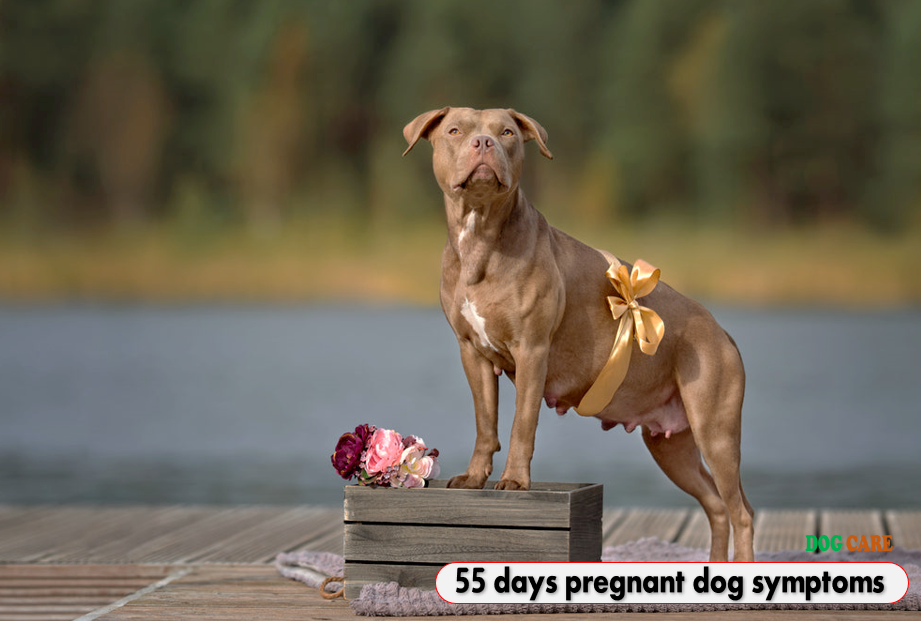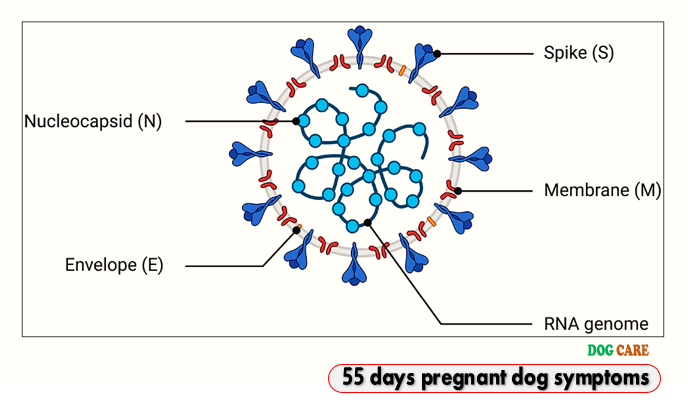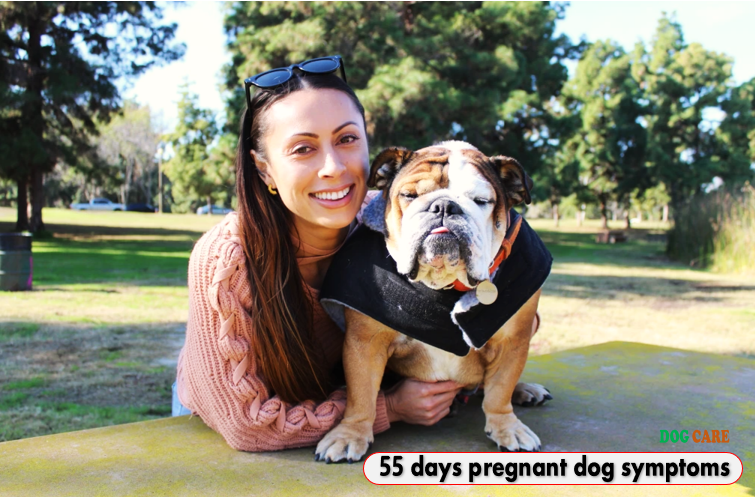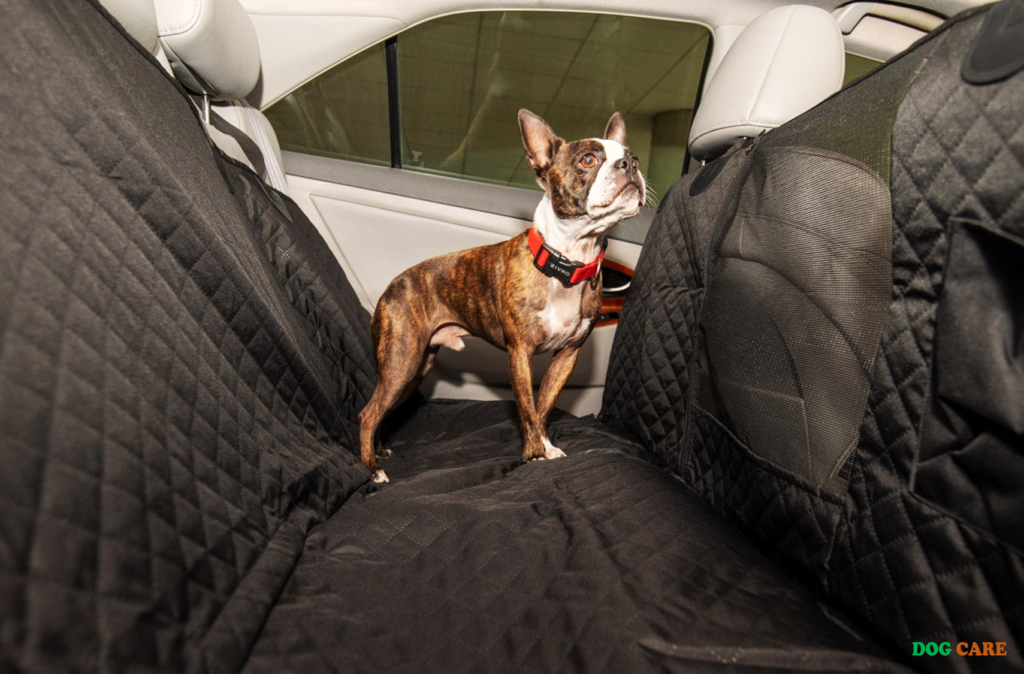55 Days Pregnant Dog Symptoms – A dog that is 55 days pregnant may display symptoms such as increased appetite and weight gain. During the course of a dog’s pregnancy, there are noticeable changes that occur, especially during the stage when the dog is 55 days pregnant.
One of the most apparent symptoms is an increased appetite, as the dog’s body requires more nutrients to support the growing puppies. Additionally, the dog may experience weight gain, as the puppies continue to develop. These symptoms are normal and indicate a healthy pregnancy.
It is important to provide the dog with a balanced diet and regular veterinary care to ensure a successful and safe pregnancy for both the mother and her puppies.

Understanding – 55 Days Pregnant Dog Symptoms
A 55-day pregnant dog may display symptoms such as weight gain, enlarged nipples, and increased appetite. It is important to understand these signs to ensure the well-being of the dog and her puppies.
Understanding Dog Pregnancy Dog pregnancy is an exciting and crucial time for both the dog and its owner. As responsible pet parents, it’s essential to understand the signs and symptoms to ensure a healthy and stress-free pregnancy. In this blog post, we will delve into the stages and symptoms of dog pregnancy, providing you with valuable insights to guide you through this incredible journey.
The Basics Of Dog Pregnancy
Dog pregnancy, also known as gestation, typically lasts for about 63 days. During this time, a female dog’s body undergoes various changes to support the development of the puppies. One of the essential aspects of understanding dog pregnancy is knowing when fertilization occurs. Unlike humans, where fertilization happens immediately, dogs’ ovaries release eggs over a period of several days. Therefore, mating with a male dog over a few days increases the chances of fertilization. Moreover, it’s important to note that a female dog’s fertility peaks around the 11th to 14th day of her heat cycle. This is the optimal time to introduce her to a male dog if you are intentionally planning a pregnancy.
Stages Of Dog Pregnancy
Dog pregnancy can be divided into three key stages: pre-implantation, embryonic development, and fetal growth. Understanding these stages will give you a better idea of what to expect during the gestation period.
Pre-implantation:
This initial stage begins immediately after fertilization. The fertilized eggs, also known as zygotes, travel through the reproductive tract and towards the uterus for implantation. During this stage, the zygotes divide and develop into blastocysts, which contain an outer cell mass and an inner cell mass.
Embryonic Development:
Once the blastocysts have successfully implanted in the uterus, the embryonic development stage begins. This stage encompasses the most critical period for the puppies’ organ development. The embryo’s cells differentiate into specific tissues and organs, laying the foundation for their overall growth and health.
Fetal Growth:
As the embryonic stage concludes, the fetal growth stage commences. This is the time when the puppies’ growth is most evident, and their individual features start to develop. The mother dog’s abdomen gradually expands as the puppies continue to grow and develop. You may even be able to feel the puppies’ movements during this stage, which is truly a magical experience. Knowing and understanding these stages will help you anticipate what to expect during your dog’s pregnancy journey.
As a responsible dog owner, it’s crucial to provide your pregnant dog with proper care, nutrition, and regular veterinary checkups. By understanding the basics of dog pregnancy and the different stages involved, you can ensure that your furry friend receives the attention and care she needs during this extraordinary time. Stay tuned for our next blog post, where we will explore the various symptoms to watch out for during dog pregnancy.
Symptoms Of A 55 Days Pregnant Dog
As your dog progresses through her pregnancy, you may notice certain changes in her physical appearance and behavior. These symptoms can help you identify if your dog is nearing the end of her pregnancy journey. In this article, we will explore the symptoms of a 55 days pregnant dog, focusing on physical and behavioral changes she may display.
Physical Changes
During the 55th day of pregnancy, your dog’s body will undergo several physical changes as her puppies continue to develop and grow. Some common physical symptoms of a 55 days pregnant dog include:
- Enlarged Abdomen: The most visible change during this stage is a noticeable increase in your dog’s belly size. Her abdomen will become rounder and firmer as the puppies grow inside her.
- Nipple Development: A pregnant dog’s nipples will become larger, darker, and more prominent as they prepare to nurse their puppies.
- Weight Gain: Due to the developing puppies and increased blood volume, your dog may gain weight during this stage of pregnancy.
- Decreased Appetite: Some dogs may experience a reduced appetite as the space in their abdomen becomes more limited. However, it’s important to monitor her food and make sure she is still receiving adequate nutrition.
- Milk Production: Towards the end of the pregnancy, your dog may start producing milk. This is a sign that her body is preparing for nursing her puppies after birth.
Behavioral Changes
Aside from the physical changes, your dog may also exhibit certain behavioral changes during the 55th day of pregnancy. These behavioral symptoms can be indicators that your dog is getting closer to delivery. Some common behavioral symptoms of a 55 days pregnant dog include:
- Restlessness: As the due date approaches, your dog may become more restless and have difficulty settling down.
- Nesting Behavior: Your dog may start exhibiting nesting behaviors, such as digging, scratching, or rearranging bedding, to create a comfortable spot for the upcoming delivery.
- Increased Affection: Some dogs become more affectionate during pregnancy and seek more attention from their owners.
- Vulva Swelling: The vulva of a pregnant dog may become swollen and appear more prominent as the body prepares for delivery.
- Changes in Energy Levels: Your dog’s energy levels may fluctuate during this stage, with some days displaying increased activity while others may be more lethargic.
It’s important to remember that each dog is unique, and not all may exhibit all the symptoms described above. However, if you notice any significant changes or concerns during your dog’s pregnancy, it’s best to consult with your veterinarian for guidance and advice.
Nutritional Needs Of A 55 Days Pregnant Dog
When your dog reaches the 55-day mark of her pregnancy, it is crucial to provide her with the right nutrition to support her health and the development of her puppies. Proper nutrition during this stage is essential for the overall well-being of both the mother and her growing puppies. In this section, we will explore the importance of proper nutrition and the recommended diet for a pregnant dog at the 55-day mark.
Importance Of Proper Nutrition
During the 55-day mark of a dog’s pregnancy, her nutritional needs change significantly. As the puppies continue to develop rapidly, the mother requires a balanced and nutritious diet to meet her own energy requirements and support the growth of the puppies. Providing proper nutrition helps ensure that the puppies receive essential nutrients and reduces the risk of developmental issues.
Recommended Diet For A Pregnant Dog
When it comes to the diet of a pregnant dog at 55 days, it is vital to focus on quality and balanced meals. The diet should consist of:
- A high-quality commercial dog food specially formulated for pregnant and nursing dogs. Look for products specifically labeled as such, as they contain the necessary nutrients and higher levels of protein and calories.
- Fresh and easily digestible protein sources. These may include lean meats like chicken, turkey, or beef, as well as fish or eggs. Be sure to cook the meat thoroughly and remove any bones or skin.
- A variety of vegetables, such as carrots, sweet potatoes, and green beans. These provide important vitamins and minerals for both the mother and the puppies.
- Complex carbohydrates, such as brown rice or oats, to give your dog energy.
- Adequate amounts of clean water should always be available for your pregnant dog to stay hydrated.
It’s important to note that each dog is unique, and it is always a good idea to consult a veterinarian to determine the specific nutritional needs of your pregnant dog. They can provide personalized guidance and recommend any additional supplements that may be necessary.

Preparing For Whelping
As your dog reaches the 55-day mark of her pregnancy, it’s essential to start preparing for whelping. This is the stage when your pregnant dog will give birth to her puppies. Being well-prepared for this momentous event will help ensure the process goes smoothly and your dog remains comfortable throughout.
Creating A Whelping Area
When it comes to creating a whelping area for your dog, you want to provide a safe and comfortable space where she can give birth and care for her puppies. Here are some key considerations:
- Choose a quiet and secluded area in your home that is free from drafts and disturbances. This will help your dog feel secure during the whelping process.
- Line the area with clean blankets or towels that can easily be washed and replaced. These will provide a soft and cozy surface for your dog and her puppies.
- Ensure the whelping area is large enough to accommodate your dog and her growing family. It should provide enough space for the puppies to nurse and move around comfortably.
- Consider installing a whelping box or a low-sided kiddie pool to help contain the puppies and keep them safe. This can prevent them from accidentally wandering away from their mother.
Gathering Essential Supplies
Preparing for whelping also means gathering essential supplies that will help you assist your dog during the birthing process and care for the newborn puppies. Here are some must-have items:
| Supplies | Description |
|---|---|
| Whelping kit | A kit containing items such as sterile gloves, surgical scissors, and umbilical cord clamps. These tools will come in handy if any intervention is required during the birth. |
| Thermometer | A thermometer to monitor your dog’s body temperature. A drop in temperature often indicates that labor is near. |
| Puppy scales | These scales will help you monitor the weight gain of the puppies, ensuring they are thriving and receiving adequate nutrition. |
| Puppy formula and bottles | In case the mother is unable to nurse or if supplemental feeding is necessary, having puppy formula and bottles on hand will ensure the puppies receive the nutrition they need. |
| Puppy pads | These absorbent pads will help keep the whelping area clean and dry, making it more comfortable for the mother and her puppies. |
By creating a suitable whelping area and gathering essential supplies, you will be well-prepared to assist your dog during the birthing process and provide the necessary care for her puppies. Remember, being proactive and prepared will help ensure a positive and stress-free experience for your beloved pet.
Monitoring The Health Of The Pregnant Dog
During a dog’s pregnancy, it is crucial to closely monitor her health to ensure the well-being of both the mother and the puppies. Regular veterinary check-ups and the ability to recognize signs of complications play a vital role in ensuring a successful pregnancy and a healthy litter.
Regular Veterinary Check-ups
Regular veterinary check-ups are essential throughout a dog’s pregnancy. These visits allow the veterinarian to closely monitor the dog’s health and address any potential issues or concerns. By conducting thorough examinations and performing necessary tests, the veterinarian can assess the dog’s overall condition and make appropriate recommendations for care.
During these check-ups, the veterinarian will typically:
- Monitor the dog’s weight gain to ensure it is within a healthy range
- Check the dog’s heart rate and listen for any abnormal sounds
- Examine the dog’s mammary glands for signs of inflammation or infection
- Perform ultrasounds or X-rays to determine the size and position of the puppies
- Test for parasites or any other underlying health conditions
These regular check-ups not only provide an opportunity for proactive care but also serve as a platform for asking questions or seeking advice from the veterinarian. Keeping a close relationship with the veterinarian ensures that any concerns or changes in the dog’s health can be addressed promptly.
Recognizing Signs Of Complications
While regular veterinary check-ups are essential, it’s also important for dog owners to be aware of potential signs of complications during their dog’s pregnancy. Recognizing these signs early can help prevent further complications and ensure both the mother’s and puppies’ safety.
Some signs of complications to watch for include:
- Persistent vomiting or diarrhea
- Loss of appetite or excessive thirst
- Difficulty breathing or coughing
- Lack of movement from the puppies
- Abnormal discharge or bleeding
- Seizures or sudden weakness
If any of these signs are observed, it’s important to contact a veterinarian immediately for guidance. Quick action and appropriate intervention can make a significant difference in the successful outcome of the pregnancy.

Frequently Asked Questions On 55 Days Pregnant Dog Symptoms
How Long Is The Gestation Period For Dogs?
The average gestation period for dogs is around 63 days, but it can range from 57 to 72 days.
What Are The Common Symptoms Of A Pregnant Dog?
Signs of a pregnant dog may include increased appetite, nipple development, weight gain, and reduced energy levels.
Is It Normal For A Pregnant Dog To Have Morning Sickness?
Yes, some pregnant dogs may experience morning sickness characterized by vomiting or loss of appetite in the early stages of pregnancy.
Can A Pregnant Dog Still Go For Walks And Exercise?
Moderate exercise is generally safe for pregnant dogs, but it’s important to consult with a veterinarian to ensure proper activity levels.
How Do You Know If A Dog Is Going Into Labor?
Signs of a dog going into labor include restlessness, nesting behavior, contractions, and a clear discharge from the vagina.
When Should I Start Preparing For The Arrival Of The Puppies?
It’s recommended to start preparing for the arrival of the puppies around week 6 of the pregnancy, including creating a comfortable whelping area.
Conclusion
To sum up, recognizing the symptoms of a pregnant dog at 55 days is crucial for her health and the success of her pregnancy. From changes in behavior to physical transformations, understanding these signs allows you to provide the necessary care and support for your furry friend.
By closely observing her and seeking veterinary guidance, you can ensure a smooth and healthy pregnancy journey for your beloved dog.


